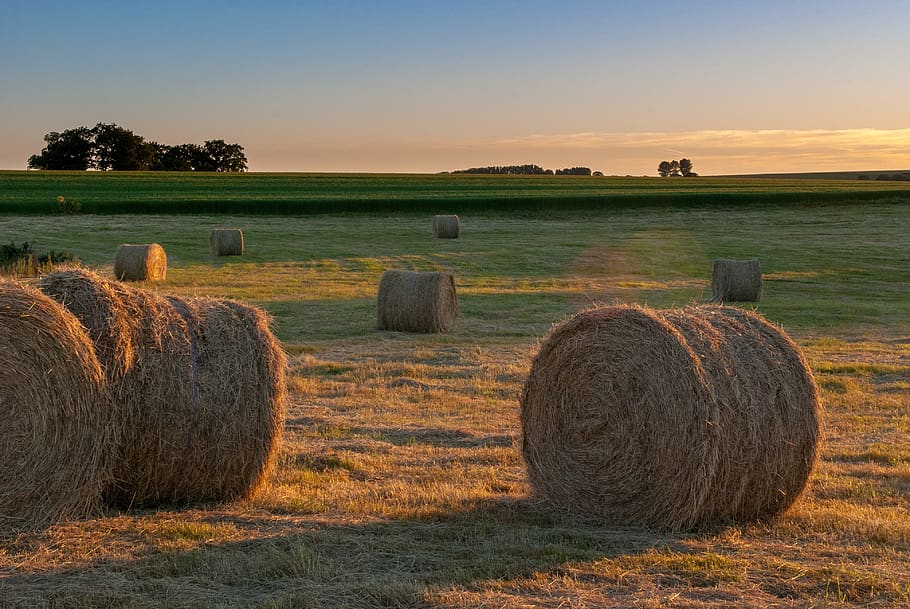
Agricultural News
Pricing Hay for Profit
Tue, 31 May 2022 09:39:35 CDT
 Hay production is one of the largest and most economically significant agricultural enterprises in Alabama with 700,000 acres farmed producing 2,170,000 tons of product valued at $217,000,000 (USDA-NASS). Hay is used as livestock feed for cattle, horses, and small ruminants. Hay can also be used as bedding, mulch, decoration, and numerous other uses. Price ranges for hay sales often depend on variety baled, the size and structure of bales, and the quality of the bale.
Hay production is one of the largest and most economically significant agricultural enterprises in Alabama with 700,000 acres farmed producing 2,170,000 tons of product valued at $217,000,000 (USDA-NASS). Hay is used as livestock feed for cattle, horses, and small ruminants. Hay can also be used as bedding, mulch, decoration, and numerous other uses. Price ranges for hay sales often depend on variety baled, the size and structure of bales, and the quality of the bale.
Prices of inputs used in agricultural production have increased in 2022 throughout the United States. Fertilizer, chemical, and fuel costs have increased significantly, leading to even more questions as to how producers should price hay to their hay consumers (and likewise what livestock producers should be willing to pay). The costs of nitrogen, phosphate, and potash used to produce a round bale of bermudagrass hay has increased 95% from May 2021 to May 2022.
Know Cost of Production
Hay producers must know their cost of production, including both fixed and variable costs. They must also determine the minimum profit margin they are willing to accept for their product. Both cost of production and acceptable profit margin will vary greatly among producers and careful consideration should be given to both.
Cost of production can be broken down into two segments: variable costs and fixed costs. Variable costs are the costs that change as our production changes, such as fertilizer. Variable costs only occur if we produce. However, as producers increase production, the amount of nutrients removed from the soil will also increase and therefore the cost of maintaining production and fertility will increase significantly.
Based on the ACES Enterprise Budgets for round bale bermudagrass hay, variable cost of production has increased 64% from May 2021 to May 2022. While this is driven primarily from higher fertilizer prices, one can see that all other costs, except the price of the soil test, has increased. We estimate the 2022 variable cost of production to be $71.88 per 1000-pound bale, up from $43.87 in 2021.
Fixed costs on the other hand will occur whether producers are actively farming or not. An easy example of fixed costs would be land taxes and depreciation both of these happen whether the producer spreads fertilizer, cuts hay, or doesn't do anything. Producers should take into account all of the equipment, land, tax, insurance and other fixed costs that are often ignored when budgeting costs for hay production.
Consider Profit Margins
There are factors beyond the cost of production that also need to be considered when pricing hay. The profit margin that producers are willing to accept is a necessary consideration. Margins can be a percentage of costs or a dollar value per unit of production and is based on the amount of profit one expects or needs on a given enterprise unit. This will vary significantly by producer and situation. Ultimately each producer must assess his own cost of production and his own acceptable profit margin when pricing their hay and each producer might be different than his neighbor.
While a price should first consider the cost of production and profit margin, one must also consider what consumers will be willing to pay. Purchasers of hay are going to consider alternative feeds and the relative price of those alternatives. If the price of alternatives has not increased much, consumers may be willing to switch to other products. Calf prices will dictate what a buyer is willing to pay. Competing products may also simply be hay from an alternative seller in a neighboring county or farther geographic location. Long-term relationships with buyers may also be circumstances where a producer may choose to limit their expected profit margin to keep current customers happy. Finally, dry weather that may reduce current or expected future supply of hay will lead to higher prices.
Article courtesy of Southern Ag Today with Ken Kelley, Adam Rabinowitz, Wendiam Sawadago & Max Runge. To see the graphics and complete article, click here:
WebReadyTM Powered by WireReady® NSI
Top Agricultural News
More Headlines...




